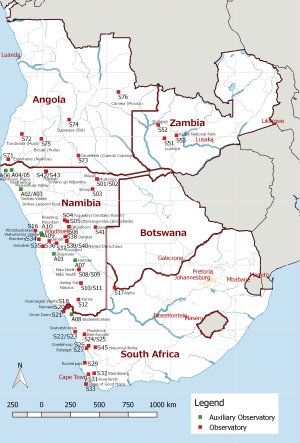 |
StartseiteHallo 2 |
|
EVI Viewer

The EVI-Viewer allows you to access the lastest pheneology and fire data from the region via the Google Earth Engine Apps.
Photo Guide to Plants of
Southern Africa
Adenium boehmianum Schinz
SASSCAL Wetternetz
Eine erhebliche Anzahl automatischer Wetterstationen wurde innerhalb des Rahmens des BIOTA AFRICA Projektes durch das namibische National Botanical Research Institute (NBRI) und die Arbeitsgruppe „Biodiversität, Evolution und Ökologie (BEE)“ der Universität Hamburg aufgebaut. Die Webseite zeigt stündliche Updates der Wetterdaten und Graphiken von vielen Parametern. Die Zahl der Wetterstationen wird im Rahmen von SASSCAL in allen SASSCAL Ländern zunehmen.
 |
SASSCAL ObservationNet
Das SASSCAL ObservationNet präsentiert Daten und nutzerfreundliche Informationen verschiedener wissenschaftlicher Disziplinen zur zeitlichen Veränderung in Ökosystemen und ihrer biologischen Vielfalt auf zahlreichen standardisierten Langzeitbeobachtungsflächen, den Biodiversitäts-Observatorien.
Im Rahmen der globalen Beobachtungssysteme von GEOSS und hier insbesondere dem Globalen Netzwerk zur Biodiversitätsbeobachtung GEO BON sind solche räumlich definierte Langzeitbeobachtungsflächen eine der wesentlichen Infrastrukturen für die Messung der Veränderungen der biologischen Vielfalt der Organismen sowie der Gesundheit der Ökosysteme.
Das SASSCAL ObservationNet mit seinen derzeit 65 Biodiverstäts-Observatorien ist einer der weltweit größten Beiträge zu dem globalen Netzwerk von GEOSS. Andere Netzwerke, die ähnlich wie SASSCAL operieren, finden sie hier. SASSCAL bemüht sich, die innerhalb von GEOSS GEO BON abgestimmten essentiellen Variablen für die Erfassung der Biodiversität Essential Biodiversity Variables (EBVs) zu verwenden.
Ebenso bemüht sich SASSCAL, auf ausgewählten Flächen auch die essentiellen Parameter für die funktionelle Beschreibung der Organismen zu ermitteln und verfügbar zu machen, entsprechend den Variablen von TRY (a global database of plant traits).
Ein Biodiversitäts-Observatorium ist ein exakt vermessener und markierter Landschaftsausschnitt von 1 Quadratkilometer Größe, der repräsentativ für eine ökologisch definierte Zone ist. Ein Biodiversitäts-Observatorium dient der Langzeitbeobachtung der Veränderung der Vielfalt und Zusammensetzung der organismischen Vielfalt und der relevanten Umweltbedingungen (z.B. im Kontext von Boden, Klima, Landnutzung). Erkenntnisse, die auf diesen gut untersuchten und dokumentierten Referenzflächen gewonnen werden, können mit wissenschaftlichen Methoden auf die Umgebung, das Land und die Region übertragen werden. Die kontinuierliche Dokumentation über viele Jahre hinweg ergibt wichtige Zeitreihen von Messwerten, die zum besseren Verständnis der Veränderungen in der Zeit beitragen.
You have the option to filter the observatories for specific (available) data.
Only those observatories where this data is available will be displayed below. North-South Direction |



 Angola
Angola Bicuar National Park
Bicuar National Park Namibia
Namibia Aussinanis
Aussinanis South Africa
South Africa Alpha
Alpha Zambia
Zambia Dongwe
Dongwe EVI Viewer of the region
EVI Viewer of the region

 Angola
Angola

 Zambia
Zambia






 Namibia
Namibia





































 South Africa
South Africa





















